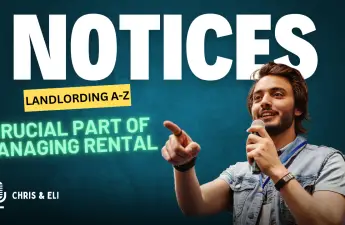In previous episodes, we discussed everything from purchasing your first rental property to the move-in process. Now that you have a tenant in place, we will move on to what might happen while you have a tenant. In this episode, we will talk about maintenance and maintenance checklists.
You might be tempted to try to avoid costly routine maintenance expenses, however we firmly believe staying on top of routine repairs saves money in the long run. Fortunately, we believe you can avoid costly mistakes using a rental property maintenance checklist. Below is a brief rundown. See the complete episode for more information.
Plumbing
Plumbing problems can be some of the worst that you may encounter as a landlord. They are often costly and the disruption caused can be inconvenient.
Here are plumbing issues we suggest you monitor regularly:
- Water heaters: Record the date each one is replaced, and schedule replacement based on the expected lifespan. In the past, we have had them fail and flood multiple apartments. Especially where a water leak can do significant damage, make sure to replace them proactively.
- Clean main drain & “stack”: Preemptively clearing main drain lines of grease and other buildup helps avoid backups that can flood your property with sewage and grey water. Once every 1-2 years is a good interval for most properties. Jetting is easier on old or delicate drain lines than using a heavy duty snake.
- Scope main drain: Knowing the condition of your drain lines can help you avoid unexpected failures, which can cause damage and disruption. Most rooter companies have cameras, and the cost has also come down dramatically, making a purchase for your rental within reach as well.
- Bathroom sinks: We recommend removing the trap and sink stopper to clear any obstruction between each tenant. Unless you know you have ABS lines we recommend against using Drain-O type products, as they can erode cast iron drain lines.
- Leak detection: Leaks under the kitchen and bathroom sinks are very common, and often go undetected (or ignored!) by tenants. Leak detectors that will sound an alarm are now readily available and inexpensive. “Smart” detectors can even alert a landlord via a phone app.
- Leaking fixtures: At all turnovers and at every routine inspection, check all fixtures to make sure they are not wasting water. Look for drips at faucets and showerheads. For toilets, put a few drops of food coloring in the tank and come back 10-15 minutes later. If the color shows up in the bowl you’ll know water is escaping the tank.
Safety & Security
Installing and maintaining safety and security products protects both your tenants and your property. In many locations, there are regulations regarding the re-keying of locks at each turnover.
- Doors: Make sure the doors to all units are solid on their hinges, close securely, and have functional locking hardware. We recommend having deadbolts on all doors, as they provide far more security than simple locking latches.
- Re-keying: Whether required or not, we recommend changing keying at every turnover to protect your tenants and avoid the potential liability that could arise if a previous occupant re-enters a unit.
- Windows: Make sure all windows latch securely. We recommend providing adjustable stops or wood dowels for all sliding windows and patio doors.
- Lights and Cameras: We have experienced an increase in property crimes at our rentals here in Seattle, and have written an article on using cameras, lights, and alarms to increase the security of your property.
Pest Control
Rental property pest control is complex and often requires the expertise of a professional in order to handle the problem effectively. If you decide to deal with these problems on your own, however, we recommend the following measures:
- Eliminate entry points: Openings can be physically covered or plugged up with a material that can’t be chewed through. Where animals are burrowing in, it is effective to fill the access point with loose pebbles, which cave in and prevent a tunnel from forming. Trees or shrubs adjacent to buildings often help pests gain access. Trimming any limbs or growth away from the building can eliminate this problem.
- Exterior Bait: Place poison outside the building in child and animal-safe containers. For rodents, we’ve found bait boxes work well. For ants and insects, there are various bait traps (we like gel products) available at local hardware stores.
- Interior Bait: For rodents, we do not recommend this as you can end up with stinky dead critters in your building. For ants and insects, there are various options that work, such as sprays that can be applied to baseboards. Some of the ant or insect traps mentioned above are also safe to use indoors – check the packaging carefully to make sure.
- Bed bugs and fleas: Both can thoroughly invade living spaces, especially where there are soft surfaces such as carpet, bedding, or furniture. It is often necessary to hire a professional to deal with infestations. There are, however, measures a landlord or tenant can take. Very high temperatures will kill either pest, and heaters are available to treat belongings, large pieces of furniture, or full rooms.
Roof & Gutters
Roof and gutter failures can cause extensive damage, but can also be avoided fairly easily with routine inspection and maintenance.
- Roof: Visually inspect your roof once a year. We suggest you do so in the fall, ahead of winter storms. Watch for loos flashing, moss growth, and broken or missing shingles. Consider having your roof professionally inspected. Inspect more frequently as the roof nears the end of its expected life in hopes of heading off failure and water damage. De-moss your roof every 1-3 years, depending on the climate you live in.
- Gutters and downspouts: Have gutters and downspouts cleaned at least once a year. Consider having a professional — who has insurance — clean your gutters & downspouts.
Chimney, Sealants, & Paint
- Chimney Inspection: Check for degraded mortar, loose bricks, and missing or inadequate flashing.
- Window and Door Sealant: Inspect caulking joints yearly and replace any that is cracked or missing.
- Paint: Replace paint before it starts bubbling or peeling, otherwise you will need to strip back to bare wood and start over in those areas.
Fire Safety and Prevention Maintenance Checklist
- Smoke and carbon monoxide detectors: Research and know how often you’re required to replace them. Test both at every turnover as well as each inspection. We suggest replacing batteries at each turnover, and making clear that it’s the tenant’s responsibility to replace batteries when necessary during their tenancy. Combined smoke & CO detectors are easy to get now, and some are wirelessly interconnectible.
- Fire Extinguishers: Find out where fire extinguishers are required and make sure they are re-certified regularly. Ideally annually.
- Escape Ladders: We provide escape ladders for each unit above the first floor. Make sure they’re on your move-in / move-out inspection list so they don’t disappear.
HVAC Maintenance Checklist
- Furnace Filters: Furnace filters must be changed regularly to extend the life of the furnace and optimize operating efficiency. Recommended once a month during heavy usage periods.
- Duct Cleaning: Having ducts cleaned every 3-5 years improves indoor air quality.
Dryer, Hood, & Fan Venting
- Dryer vent cleaning: Clogged dryer vents cause many fires each year. Make sure tenants know to clean the lint filter in the dryer after each use, as this will cut down on fire risk and increase the efficientcy of the machine. There are lots of handy tools available that make it easy to clean dryer vents.
- Hood and fan cleaning: Bath and kitchen venting should also cleaned. Cleaning kitchen vent screens often helps avoid the buildup of grease. We run bath fan covers and hood filters through the dishwasher at each turnover.
Takeaway
To keep your property in good shape, we highly recommend following a maintenance checklist. This can help avoid issues that could have been avoided.

Landlording A-Z Series:
Our Landlording A-Z series will walk you through each of the stages, tasks, and issues involved in rental real estate investing. In our next installment, we’ll discuss getting repair and maintenance tasks completed.




